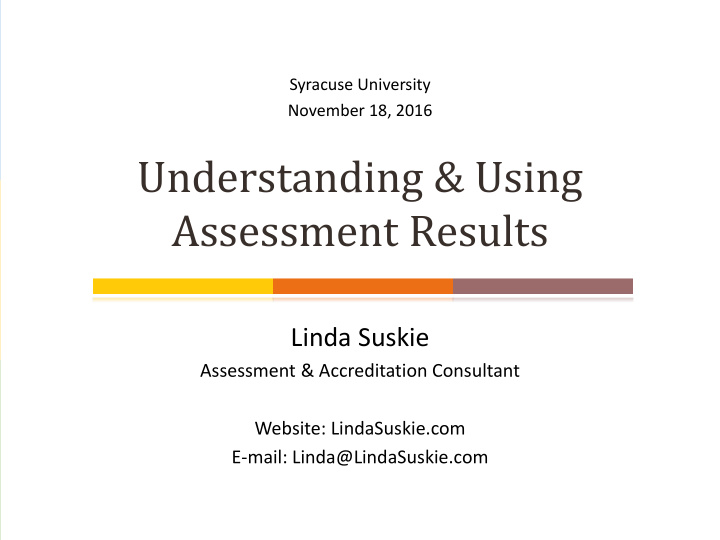



Syracuse University November 18, 2016 Understanding & Using Assessment Results Linda Suskie Assessment & Accreditation Consultant Website: LindaSuskie.com E-mail: Linda@LindaSuskie.com
Time to Talk! Scenarios for Discussion
Lessons learned that you might apply to using Syracuse assessment results? Why is it such a challenge to use assessment results to… Improve teaching and learning? Inform plans and resource decisions?
Why is Using Results a Challenge?
#1. We do not have a tradition of using research results. Research Assessment Purpose Key learning outcomes Hypothesis Standards and targets Methodology Assessment methods Summary of results Summary of results Analysis and Analysis and conclusions conclusions Recommendations for Use of results to inform further research improvements & decisions
#2. We need to set defensible standards and targets. Standard Minimally adequate performance Target The proportion of students we want to meet the standard
What is a standard? The minimum level students need in order to: Succeed in the next course. Succeed in the workplace. Succeed in the next degree program. The level that would not embarrass you
Standards vary by course level. Foundation courses Cornerstone courses Capstone courses Use a developmental rubric to connect standards throughout your program.
What is a target? The proportion of students you want to meet your minimally adequate standard If essential for health & safety, 100% If essential for subsequent success, close to 100% If not essential… why is it a program outcome? Would you be happy if all your students were minimally adequate…but none were exemplary? Consider an additional target for outstanding or exceptional performance.
Time to Talk! CRS 455 Critique Rubric Learning outcome: Design, execute, and write an original research project. Scenario: If your program used this to evaluate senior research projects, What should be the minimally adequate performance for each criterion at that level? You would expect almost 100% of seniors to score at this level. Circle the boxes that best describe minimally adequate performance. Your circled boxes may not all be in the same column.
Time to Talk! Public Health B.S. Assessment & Action Plan Of the 12 learning outcomes in this report, Which ones should the faculty celebrate as successfully achieved by students? For which one would you most like to see student learning improved? Why did you choose that one?
#3 We do not have a pervasive culture of collaborating to knit pieces together.
Student-Level Assessment Assess individual students on course-level goals Tests & assignments, summarized into a grade Generally in isolation
Class-Level Assessment Assess students as a whole on course-level goals Tests and assignments Item scores aggregated across students In isolation
Course-Level Assessment Assess students as a whole on course-level goals Tests and assignments Scored with a common scoring key or rubric Aggregated across sections Examined holistically for pervasive concerns Collaboratively
Program-Level and Gen Ed Assessment Assess students as a whole on program or gen ed goals Key “capstone” assignments “Embedded” in “capstone” courses and other key courses Scored with a common rubric Field experience supervisor evaluations Portfolios Published tests Collaboratively
#4. Graphs are faster and easier to understand than tables. English & Textual Studies 303, 305, 310, 320, 410 Learning outcome Excellent High Able Inchoate Un- Able but Accep- accep- table table Recognize how meanings 31 2 35 14 3 are created through critical reading and analysis of texts. Formulate sustained 24 1 41 15 3 interpretive, analytical, or conceptual argument
English & Textual Studies 303, 305, 310, 320, 410 Recognize how meanings are created through critical reading and analysis of texts Formulate sustained interpretive, analytical, or conceptual argument 0% 10% 20% 30% 40% 50% 60% 70% 80% 90% 100% Unacceptable Inchoate but Acceptable Able High Able Excellent What might faculty do with this information? Any budget implications?
ETS Faculty Observations Some papers fell between rating levels; they had characteristics of both higher and lower ratings. Few students could both mount an interesting argument AND support it with nuanced analysis. Students did not complete the assignment as intended Shorter papers Made arguments unrelated to the assignment Inchoate papers had weak arguments. Some inchoate papers were from students dealing with personal issues.
ETS Action Steps Revise required ETS 242 (Reading and Interpretation) to emphasize close-reading as well as a few dominant paradigms of interpretation. Add Advanced Critical Writing courses with significant “ scaffolded ” assignments with analytical and conceptual argumentation.
#5. Design assessments with the end in mind: Improving teaching and learning. Align rubrics, rating scales, and grading criteria with major learning outcomes and their essential traits. Analytic rubrics are harder to develop but are often easier to use.
Time to Reflect!
Recommend
More recommend